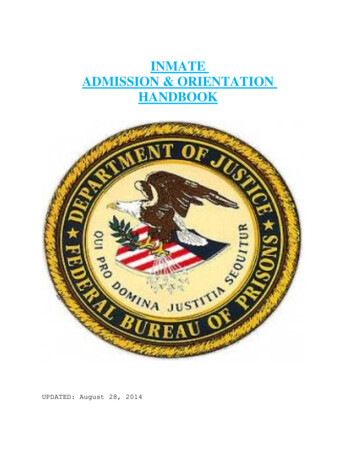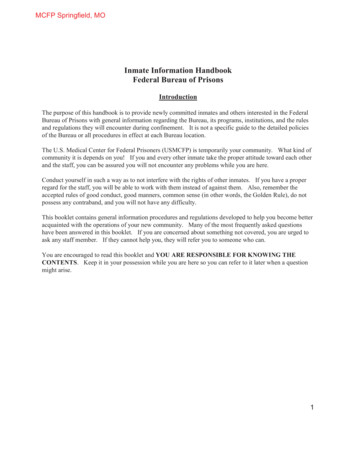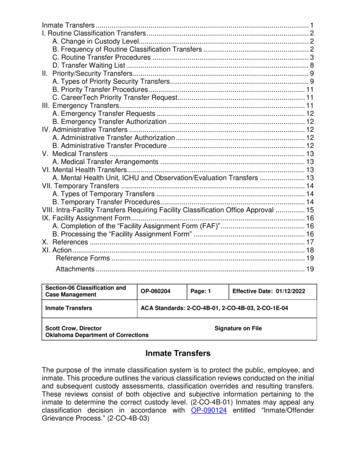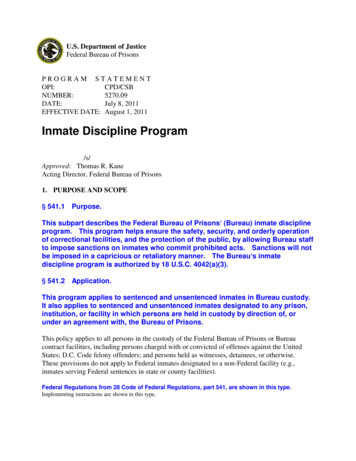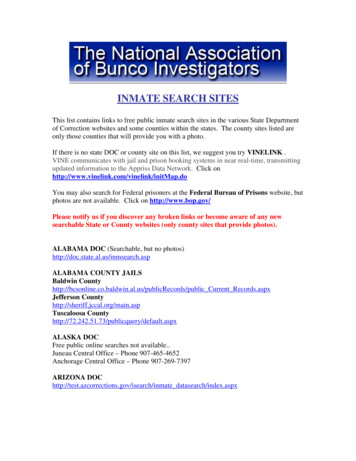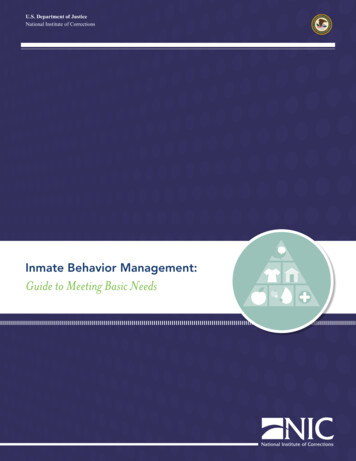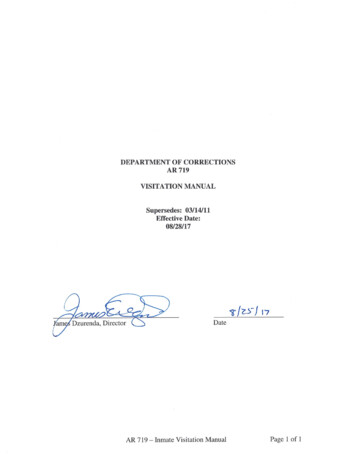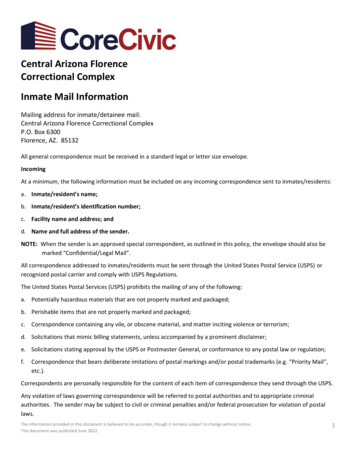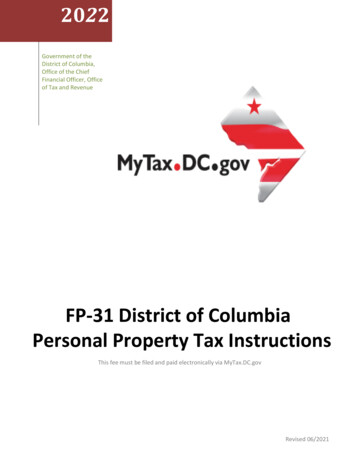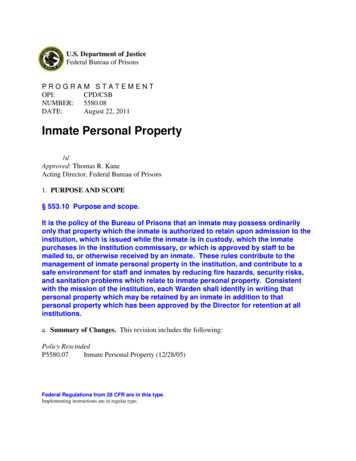
Transcription
U.S. Department of JusticeFederal Bureau of PrisonsPROGRAM STATEMENTOPI:CPD/CSBNUMBER: 5580.08DATE:August 22, 2011Inmate Personal Property/s/Approved: Thomas R. KaneActing Director, Federal Bureau of Prisons1. PURPOSE AND SCOPE§ 553.10 Purpose and scope.It is the policy of the Bureau of Prisons that an inmate may possess ordinarilyonly that property which the inmate is authorized to retain upon admission to theinstitution, which is issued while the inmate is in custody, which the inmatepurchases in the institution commissary, or which is approved by staff to bemailed to, or otherwise received by an inmate. These rules contribute to themanagement of inmate personal property in the institution, and contribute to asafe environment for staff and inmates by reducing fire hazards, security risks,and sanitation problems which relate to inmate personal property. Consistentwith the mission of the institution, each Warden shall identify in writing thatpersonal property which may be retained by an inmate in addition to thatpersonal property which has been approved by the Director for retention at allinstitutions.a. Summary of Changes. This revision includes the following:Policy RescindedP5580.07Inmate Personal Property (12/28/05)Federal Regulations from 28 CFR are in this type.Implementing instructions are in regular type.
Updates lists of inmate property. Removes requirement for radios to be engraved. Clarifies the process of confiscation and disposition of cash and negotiableinstruments as contraband. Removes Attachment B – Approved Athletic/Specialty Shoe. Attachment A and Bare incorporated into one attachment.b. Program Objectives. The expected results of this program are: Inmates will be permitted to retain and store authorized personal property. Contraband items found in the possession of inmates or in inmate living or work areaswill be properly identified, processed, and discarded.c. Pretrial/Holdover Procedures. Procedures required in this Program Statement apply topretrial and holdover inmates.2. LIMITATIONS ON INMATE PERSONAL PROPERTY§ 553.11 Limitations on inmate personal property.(a) Numerical limitations. Authorized personal property may be subject tonumerical limitations. The institution’s Admission and Orientation program shallinclude notification to the inmate of any numerical limitations in effect at theinstitution and a current list of any numerical limitations shall be posted oninmate unit bulletin boards.(b) Storage space. Staff shall set aside space within each housing area for useby an inmate. The designated area shall include a locker or other securable areain which the inmate is to store authorized personal property. The inmate shall beallowed to purchase an approved locking device for personal property storage inregular living units. Staff may not allow an inmate to accumulate materials to thepoint where the materials become a fire, sanitation, security, or housekeepinghazard.The amount of space provided depends upon the number of inmates assigned to that housingarea.Allowing an inmate to retain excess personal property increases the likelihood that property willbe damaged or lost, and thereby increases the risk to the Bureau of liability claims.By providing secured space, and adhering to guidelines on retention of property, the individualinmate has responsibility for securing personal property.P5580.088/22/2011Federal Regulations from 28 CFR: this type. Implementing instructions: this type.2
(c) Clothing. Civilian clothing (i.e., clothing not issued to the inmate by theBureau or purchased by the inmate from the commissary) ordinarily is notauthorized for retention by the inmate. Civilian clothing which previously hadbeen approved for retention may not be retained after August 6, 1999. Prereleasecivilian clothing for an inmate may be retained by staff in the Receiving andDischarge area during the last 30 days of the inmate’s confinement. Blue/Black/Red/Camouflage Clothing. No inmates may be issued, permitted to purchase,or have in their possession any clothing items, or pieces of cloth, in the aforementionedcolors. Civilian Clothing. All inmates are prohibited from wearing any clothing not governmentissued or purchased in the commissary.(1) Commissary Clothing Inventory. Wardens will restrict clothing to the following colors: Only gray and/or white clothing may be sold in institutions for males and only pastel green,gray, and/or white may be sold in institutions for females. The only exception is for religious headgear.(2) Shoes. The following may be stocked or sold through the SPO process: Athletic, specialty shoes (i.e., a court, turf, basketball, or running shoe) ( 100 maximumselling price with no pumps, no pockets) in black or white, or a combination of black orwhite, or with gray markings (no other colors allowed). (2 pr) Casual (such as hushpuppies). (1 pr) Shower. (1 pr) Slippers. (1 pr) Work (ASTM Standard F2412-05 and F2413-05). (1 pr)Commissaries will be the sole source for inmates to purchase athletic shoes and only supplyshoes that sell for 100 or less.(d) Legal materials. Staff may allow an inmate to possess legal materials inaccordance with the provisions on inmate legal activities (see § 543.11 of thischapter).(e) Hobbycraft materials. Staff shall limit an inmate’s hobby shop projects withinthe cell or living area to those projects which the inmate may store in designatedpersonal property containers. Staff may make an exception for an item (forexample, a painting) where size would prohibit placing the item in a locker. Thisexception is made with the understanding that the placement of the item is at theinmate’s own risk. Staff shall require that hobby shop items be removed from theliving area when completed, and be disposed of in accordance with theP5580.088/22/2011Federal Regulations from 28 CFR: this type. Implementing instructions: this type.3
provisions of part 544, subpart D of this chapter.Part 544, Subpart D refers to the Program Statement Inmate Recreation Programs, which setslimits on the amount of materials which can be purchased quarterly.(f) Radios and Watches. An inmate may possess only one approved radio andone approved watch at a time. The inmate must be able to demonstrate proof ofownership. An inmate who purchases a radio or watch through a Bureau ofPrisons commissary is ordinarily permitted the use of that radio or watch at anyBureau institution if the inmate is later transferred. If the inmate is not allowed touse the radio or watch at the new institution, the inmate shall be permitted tomail, at the receiving institution's expense, the radio or watch to a destination ofthe inmate’s choice. Where the inmate refuses to provide a mailing address, theradio and/or watch may be disposed of through approved methods, includingdestruction of the property.Inmates may not retain other audio equipment, such as tape players/recorders, or radios with tapeplayers/recorders, except as provided for the Program Statement Legal Activities, Inmate or assold through the Commissary.Where appropriate, certain department heads (e.g., Supervisor of Education, SupervisoryChaplain, and/or Unit Manager) may provide this type of equipment for use by inmatesparticipating in self-study courses or other programs.Such equipment will only be used in the program area and will not be permitted in inmate livingquarters, except in medical centers where inmates are medically confined to the unit.Wardens will take steps to reasonably accommodate inmates with disabilities in conformancewith the Rehabilitation Act of 1973, which prohibits discrimination on the basis of disability inFederally-assisted programs.In such cases, appropriate security procedures must be developed, and both tape players and tapesbe limited to those available through state and Federal agencies providing these services to thedisabled.A Warden may determine that it is more appropriate to accommodate an inmate in anothermanner (for example, by providing volunteer readers).Watches must have a selling price of no more than 100, no stones, and be electronicallyunsophisticated (i.e., unable to send or receive signals).Language translators are permitted to inmates who have displayed a need.(g) Education Program Materials. Education program materials or currentcorrespondence courses may be retained even if not stored as provided inP5580.088/22/2011Federal Regulations from 28 CFR: this type. Implementing instructions: this type.4
paragraph (b) of this section.Only education, religious study materials, and correspondence materials pertaining to currentcourse work may be retained.Once an educational course is completed, associated books and materials must be removed fromthe living area or be included as part of an inmate s correspondence and reading materials.(h) Personal Photos. An inmate may possess photographs, subject to thelimitations of paragraph (b) of this section, so long as they are not detrimental topersonal safety or security, or to the good order of the institution.Ordinarily, photographs, particularly those of family and friends, are approved, since theyrepresent meaningful ties to the community.A personal photograph is defined as a photograph intended for individual viewing, as opposed toa photograph published for commercial use. Personal photographs may be stored or displayed inthe housing units according to local sanitation and housekeeping guidelines.Inmates may not retain Polaroid photos.Nude or sexually suggestive photos (individual prints or copies as opposed to those frompublications) present special concerns about personal safety, security, and good order,particularly when the subject is an inmate s relative, friend, or acquaintance or could reasonablybe perceived as such. For these reasons, an inmate may not be permitted to retain, receive, orpossess a personal photograph in which the subject is partially nude or nude, or when thephotograph depicts sexual acts such as intercourse, fellatio, or sodomy. These materials will bereturned to the sender upon receipt at the institution.An inmate may possess 25 loose photos. In addition to these photos, an inmate may possess aphoto album containing photos, provided they are properly stored in the photo album.i. Religious Items. Each inmate, upon commitment, will be permitted to retain religious itemsapproved by the Warden.Ordinarily, inmates will be permitted to retain one religious medallion and chain with no stones,non-metallic. The item will not be valued more than 100.The Warden will authorize retention of religious items unless they pose a threat to the securityand orderly running of the institution.Inmates may not receive these items from home.P5580.088/22/2011Federal Regulations from 28 CFR: this type. Implementing instructions: this type.5
Items of religious wearing apparel include, but are not limited to: Prayer shawls and robes.Kurda or ribbon shirts.Medals and pendants (as noted above).Medicine pouches.Various types of approved headwear.Personal religious property may be purchased only from commissary stock or from a Chaplainapproved catalogue using the Special Purchase Order process.The inmate must have prior approval from the Chaplain. The Religious Beliefs and PracticesInstitution Supplement must include proper acquisition procedures for those items not availablethrough a catalogue.Religious headwear is permitted in all areas of the institution, subject to normal considerations ofsecurity and good order, including inspection by staff.Guidance for approved religious headwear and attire is found in the Program StatementReligious Beliefs and Practices.Religious headwear and/or attire which has been altered without staff approval is contraband.j. Consumable Awards. Bureau entities such as Education, UNICOR, and RecreationDepartments may provide consumables as awards to recognize inmate achievements.Consumables such as soda, cookies, hygiene items, small monetary awards, paper certificates,etc., are to replace property awards.Property awards such as trophies, hats, tee shirts, mugs, pens, etc., are not authorized at anyinstitution.k. Packages From Home. The only packages an inmate may receive from home are thosecontaining release clothing and authorized medical devices.Release clothing packages may only be received within the last 30 days of confinement. Thisclothing will be stored in R&D and not released to the general population.Medical devices such as hearing aids, eyeglasses, dentures, wheelchairs, braces, orthopedic/prescription shoes, and artificial limbs are authorized if medically required and approved by theHealth Services Administrator.P5580.088/22/2011Federal Regulations from 28 CFR: this type. Implementing instructions: this type.6
3. PERSONAL PROPERTY LIST AND RECORDSThe Inmate Personal Property List (Attachment A), includes all personal property that an inmatecan retain at every institution, including non-government property approved for use at all Bureauinstitutions and permitted for transfer between institutions.This includes any medical device which is either issued or approved by the Health Services Unit(HSU) prior to it being added to the inmate’s personal property list.Should an inmate transfer to another institution, this property may be sent along with the inmateor his or her property at the discretion of the sending and receiving institutions’ Wardens.While the institution may set a limit on the number of specific items that the inmate may retain,this limit may not exceed the capacity of the local specified area or container designated forinmate clothing.a. Additional Property Items. The Warden must approve any item of inmate property notfound in Attachment A and then only for local and short-term retention.Items that are added to an inmate s property list may vary by institution due to climatic, cultural,or other reasons. All such property will be clearly identified when sold at Commissary as forlocal use only.Property approved for local use will be mailed home at the inmate s expense upon transfer orrelease. If abandoned by the inmate, the property will be disposed of in accordance with theProgram Statement Property Management Manual, Chapter 11, sec. 2.Examples of items identified for possession at the Warden s discretion are listed in AttachmentA.b. Personal Property Record. A copy of the Inmate Personal Property Record (BP-A0383)will be given to the inmate during the initial property inventory or any subsequent inventory.This form and/or a commissary receipt constitutes proof of ownership, not proof of value.c. Inmate Property Inventory Records. The BP-A0383 will be used to inventory all inmateproperty except when: The Authorization to Receive Package or Property (BP-A0331) will be used to inventoryrelease clothing received from an outside source. The Warden elects to use a local form instead; for instance, when an inmate moves fromAdministrative Detention to Disciplinary Segregation or from Disciplinary Segregation toAdministrative Detention.P5580.088/22/2011Federal Regulations from 28 CFR: this type. Implementing instructions: this type.7
Regardless of the form used, a written record of that inventory will be retained in the SpecialHousing Unit (SHU) for at least two years. A copy of the Inmate Personal Property Record formwill also be kept in the Inmate Central File.The Request-Authorization to Mail Inmate Package (BP-329), must be used to inventory propertywhich is authorized for retention, but not authorized for shipment at Bureau expense (the inmateincurs the cost of mailing).4. CONTRABAND§ 553.12 Contraband.(a) Contraband is defined in §500.1 (h) of this chapter. Items possessed by aninmate ordinarily are not considered to be contraband if the inmate wasauthorized to retain the item upon admission to the institution, the item wasissued by authorized staff, purchased by the inmate from the commissary, orpurchased or received through approved channels (to include approved forreceipt by an authorized staff member or authorized by institution guidelines).Contraband includes material prohibited by law, or by regulation, or material which canreasonably be expected to cause physical injury or adversely affect the security, safety, or goodorder of the institution.For example, a manual describing the operation of the Bureau s data processing equipment wouldbe considered contraband if possessed by an inmate because of the threat it would pose to thesecurity, safety, and good order of the institution.(b) For the purposes of this subpart, there are two types of contraband.(1) Staff shall consider as hard contraband any item which poses a serious threatto the security of an institution and which ordinarily is not approved forpossession by an inmate or for admission into the institution. Examples of hardcontraband include weapons, intoxicants, and currency (where prohibited).Other examples of hard contraband include: Tools which may be used to aid in an escape (e.g., rope).Ammunition or explosives.Combustible or flammable liquids.Knives or tools not provided in accordance with the Program Statement CorrectionalServices Manual. Hazardous or poisonous chemicals and gases.P5580.088/22/2011Federal Regulations from 28 CFR: this type. Implementing instructions: this type.8
Narcotics or other controlled substances not dispensed or approved by the institution HSU arealso hard contraband.Medicine the HSU dispensed or approved is hard contraband if not possessed by the inmate forwhom it was prescribed or if not consumed or used in the manner prescribed.Staff must consult the institution pharmacist or other health services staff member in any caseinvolving questions whether a prescribed medication represents contraband.Medicines the inmate carries into the institution at the time of commitment (e.g., voluntarycommitment) will be forwarded to the institution medical staff for disposition. If appropriate,this medicine will be returned to the inmate.(2) Staff shall consider as nuisance contraband any item other than hardcontraband, which has never been authorized, or which may be, or whichpreviously has been authorized for possession by an inmate, but whosepossession is prohibited when it presents a threat to security or its condition orexcessive quantities of it present a health, fire, or housekeeping hazard.Examples of nuisance contraband include: personal property no longer permittedfor admission to the institution or permitted for sale in the commissary; alteredpersonal property; excessive accumulation of commissary, newspapers, letters,or magazines which cannot be stored neatly and safely in the designated area;food items which are spoiled or retained beyond the point of safe consumption;government-issued items which have been altered, or other items made fromgovernment property without staff authorization.The Warden may set limits locally, based on available storage space, on the amount ofcommissary items, newspapers, magazines, etc., each inmate may retain.5. PROCEDURES FOR HANDLING CONTRABAND§ 553.13 Procedures for handling contraband.(a) Staff shall seize any item in the institution which has been identified ascontraband whether the item is found in the physical possession of an inmate, inan inmate’s living quarters, or in common areas of the institution.(b) Staff shall dispose of items seized as contraband in accordance with thefollowing procedures.Exceptions to these procedures may occur only upon written authorization of the Warden ordesignee.P5580.088/22/2011Federal Regulations from 28 CFR: this type. Implementing instructions: this type.9
The procedures described in this section apply to and include property found in the inmate sphysical possession, in an inmate s living quarters, or in common areas of the institution.These procedures also encompass the property of inmates processed through Receiving andDischarge (R&D), such as new commitments and inmates received through transfer.When religious items are confiscated the chaplain must be consulted as to the validity of theitems.(1) Staff shall return to the institution’s issuing authority any item of governmentproperty seized as contraband, except where the item is needed as evidence fordisciplinary action or criminal prosecution. In such cases, staff may retain theseized property as evidence.Seized government property, if not altered, may be placed in normal stock for reissue.Altered government property, including items an inmate made from government property withoutstaff authorization, will be destroyed at the Warden’s discretion.The Warden may delegate the authority to determine if altered government property is to bedestroyed.The chaplain must be consulted regarding the disposition of religious items confiscated.(2) Items of personal property confiscated by staff as contraband are to beinventoried and stored pending identification of the true owner (if in question)and possible disciplinary action. Following an inventory of the confiscated items,staff shall employ the following procedures.(i) Staff shall provide the inmate with a copy of the inventory as soon aspracticable. A copy of this inventory shall also be placed in the inmate’s centralfile.Placing a copy of the inventory in the Inmate Central File will assist staff in the investigation ofpossible tort claims.(ii) The inmate shall have seven days following receipt of the inventory to providestaff with evidence of ownership of the listed items. A claim of ownership maynot be accepted for an item made from the unauthorized use of governmentproperty. Items obtained from another inmate (for example, through purchase, oras a gift) without staff authorization may be considered nuisance contraband forwhich a claim of ownership is ordinarily not accepted.P5580.088/22/2011Federal Regulations from 28 CFR: this type. Implementing instructions: this type.10
(iii) If the inmate establishes ownership, but the item is identified as contraband,staff shall mail such items (other than hard contraband), at the inmate’s expense,to a destination of the inmate’s choice. The Warden or designee may authorizethe institution to pay the cost of such mailings when the item had not beenaltered and originally had been permitted for admission to the institution or hadbeen purchased from the commissary, or where the inmate has insufficient fundsand no likelihood of new funds being received. Where the inmate hasestablished ownership of a contraband item, but is unwilling, although financiallyable to pay postage as required, or refuses to provide a mailing address forreturn of the property, the property is to be disposed of through approvedmethods, including destruction of the property.The Confiscation and Disposition of Contraband form (BP-A0402) will be completed.Ordinarily, the Correctional Systems Manager (CSM) is responsible for authorizing theinstitution to pay mailing costs.(iv) If the inmate is unable to establish ownership, staff shall make reasonableefforts to identify the owner of the property before any decision to destroy theproperty is made.(v) Staff shall prepare and retain written documentation describing any itemsdestroyed and the reasons for such action.Destroying contraband will be accomplished as follows: Ordinarily, the CSM (for R&D only) or Captain or designee receives the inmate’s proof ofownership and determines if an item is contraband. When it is determined that the item is to be destroyed, the CSM (for R&D only) or Captain ordesignee will prepare the written documentation describing the item(s) destroyed and thereasons for this action. Ordinarily, property is held for 120 days before it is destroyed. This delay allows an inmatethe opportunity to obtain proof of ownership and/or appeal the decision through theAdministrative Remedy Procedure. The employee who actually destroys the property, and at least one staff witness to thedisposal, will state in writing that they have witnessed the destruction. Records of disposal of property will remain on file for at least two years to ensure theavailability of information necessary to an investigation of a subsequent tort claim.(vi) Where disciplinary action is appropriate, staff shall delay disposition ofproperty until completion of such action (including appeals).P5580.088/22/2011Federal Regulations from 28 CFR: this type. Implementing instructions: this type.11
(c) Staff shall retain items of hard contraband for disciplinary action orprosecution or both. The contraband items may be delivered to law enforcementpersonnel for official use. When it is determined that the item is not needed forcriminal prosecution, the hard contraband shall be destroyed as provided inparagraph (b)(2)(v) of this section. Written documentation of the destruction shallbe maintained for at least two years.(d) Staff may not allow an inmate to possess funds in excess of establishedinstitutional limits. Staff shall deliver to the cashier any cash or negotiableinstruments found in an inmate's possession which exceed the institution'sallowable limits. Funds determined to be contraband shall be confiscated forcrediting to the U.S. Treasury.All cash and negotiable instruments in the possession of inmates is unauthorized.Cash and negotiable instruments that were inadvertently delivered to the inmate via the mail andare immediately turned over to staff shall be returned to the mail room to be processed inaccordance with the Program Statement Correspondence.All other cash and negotiable instruments found in the inmate s possession shall be processed ascontraband. The cash and negotiable instruments shall be turned over to the cashier.(1) Where disciplinary action against the inmate is appropriate, staff shall delayfinal disposition of the funds until such action (including appeals) is completed.(2) Prior to a decision on the disposition of funds, staff shall allow the inmate areasonable amount of time to prove ownership.6. INMATE TRANSFER BETWEEN INSTITUTIONS AND INMATE RELEASE§ 553.14 Inmate transfer between institutions and inmate release.(a) Except as provided for in paragraphs(a)(1) through (3) of this section,authorized personal property shall be shipped by staff to the receiving institution.(1) The Warden ordinarily shall allow an inmate transferring to another institutionto transport personal items determined necessary or appropriate by staff and, ifapplicable, legal materials for active court cases.(2) The Warden may require or allow an inmate who is transferring to anotherinstitution under furlough conditions to transport all the inmate’s authorizedpersonal property with him or her.P5580.088/22/2011Federal Regulations from 28 CFR: this type. Implementing instructions: this type.12
(3) An inmate who is being released or who is transferring to a CommunityCorrections Center may arrange to ship personal property at the inmate’sexpense. The inmate is responsible for transporting any personal property not soshipped.(b) If the inmate’s personal property is not authorized for retention by thereceiving institution, staff at the receiving institution shall arrange for theinmate’s excess personal property to be mailed to a non-Bureau destination ofthe inmate’s choice. The inmate shall bear the expense for this mailing.(c) Whenever the inmate refuses to provide a mailing address for return of theproperty or, when required, refuses to bear the expense of mailing the property,the property is to be disposed of through approved methods, includingdestruction of the property.This property determination is to be made in the receiving institution s R&D unit when theinmate s property is processed (i.e., inventoried) in the inmate s presence. Bureau institutionswill accept for each inmate the property approved in this Program Statement as authorized forretention and transfer between Bureau institutions. Staff will adhere to the procedures thatfollow with respect to an inmate s property while he or she is in transfer between institutions.d. Sending institution staff will ship authorized property of inmates transferring via bus, van, orairlift directly to receiving institutions. Ordinarily, no more than two boxes of property, size 14"x 14" x 19", will be shipped at government expense for each inmate. The inmate may elect topay for expenses related to the shipment of authorized personal property beyond the two boxes.Institutional clothing and shoes for an inmate with special needs (large sizes, small sizes,orthopedic designs, orthopedic shoes, appliances, clothing, insulin testing kits, etc.), may beshipped at government expense in addition to the two-box maximum when the inmate transfersto another Bureau institution. All other Bureau-issued clothing will not be transferred.Property of inmates transferring on furlough will also be handled in this same manner.Legal property will be exempt from this two-box limit.e. Bureau buses and vans will accept two standard size (14" x 14" x 19") boxes for transportwith the inmate when the same bus or van delivers the inmate to the final destination. Thisshipment will be in lieu of the two boxes which would normally be mailed at governmentexpense.f. Essential Daily Prayer items, as authorized by the Warden, must be delivered to transportingofficials upon the inmate s removal. The inmate is responsible for production of the items, in theP5580.088/22/2011Federal Regulations from 28 CFR: this type. Implementing instructions: this type.13
authorized container (authorization affixed by Chaplain), to the R&D Officer. The items will bere-issued to the inmate for daily use at all holdover points.The Chaplaincy Services Branch, Central Office, will provide sample authorization forms and asample container to each location for use in the issuance of essential daily prayer items.g. R&D staff will use a Transfer Receipt (BP-A0821), for receipting all packages delivered totransporting officials in accordance with the above changes.A separat
P5580.08 8/22/2011 Federal Regulations from 28 CFR: this type.Implementing instructions: this type. 4 provisions of part 544, subpart D of this chapter. Part 544, Subpart D refers to the Program Statement Inmate Recreation Programs, which sets limits on the amount of materials which can be purchased quarterly.

